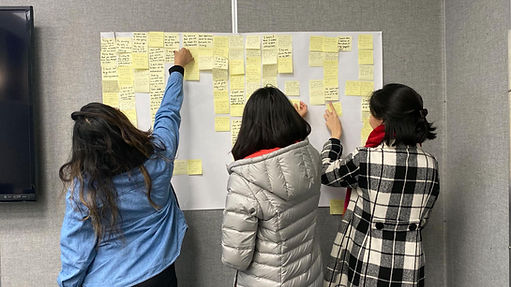Overview
The project involves applying design thinking methods and tools to solve the problem of food waste management by preventing it in the first place by creating a community-based system and involving the thought if circular economy. The project was done in a timeframe of 10 weeks.
My Key Role
Project Manager: Management, User Research, Design Research, Interaction Design, Visual Design, Strategy and Planning

Design Process

Umbrella Question
Sub Questions
How might we transform consumer behavior in order to reduce food waste and make them as agents of change?
How might we use Behavioral Research tools to understand people’s awareness and an understanding of food wastage?
• How might we leverage efforts from consumers’ end to reduce food waste in public eateries?
• How might we use design thinking to introduce new channels for consumers to reduce food waste?
Secondary Research



The focus of the study

We conducted secondary research to understand the impacts of each level. After understanding the scope we decided to work towards the Prevention level which would lead to greater opportunities as compared to the other 2 levels.

Opportunity Matrix
A 2X2 matrix is a tool helped us to scaffold a conversation about insights and findings. We created a 2X2 matrix with opposing characteristics on each end of the spectrum (ie. Low cost vs high cost on the Y-axis and Sharing vs not sharing on the X-axis). This helped us to sort our ideas/insights according to where these variables fall along the spectrum and what is the scope of opportunity within them.
The SWOT Analysis, helped us to evaluate an our project’s strengths, weaknesses, opportunities, and threats. The analysis began with studying the project and its innovations and seeks to understand how the project performs in relation to competitors in the market. A high-level assessment is made of the strengths and weaknesses of the project, the opportunities available as well as competitive threats. It also helped us look at the factors inside and outside the project to determine whether defined objectives are achievable or not.


Knowing the users


To analyze the stakeholders involved in preventing food waste, we mapped them out into a stakeholder map. The map helped us indenting all the active stakeholders involved and their roles and interests in the subject matter. It also helped us ensure that we had the correct representation and involvement in order to touch the possible interventions in the future of our project. We conducted 11 in-depth interviews that lasted for 30-45 minutes.
We also conducted participant observation studies in 14 restaurants/cafes to under consumer behavior, portion sizes and other areas that could lead to food waste





Framing Insights
Empathy Maps


User Persona Maps



Current User Journey Map





Core Stories
Designing Concepts

The insights led us to various key points that had possible opportunities to be explored in the intervention phase.
After repeated affinity mapping, the team came up with 3 major principles and sketched 10-15 solutions. These sketches were further affinitized and the designs with greater scopes and opportunities were taken forward for prototype testing and final designs




Prototype Testing






Prototype Details
Our first concept was based on a smart tray which would help us weigh the food waste generated by the restaurant customer. The idea was to weigh the waste and record data about the type of food being wasted. This data would further help the restaurant to change its menu and portion sizes. We prototyped this concept using paper prototypes.
Prototype Feedback
We received constructive feedback through our prototyping sessions and also got some insights from our professor. The idea of a smart tray was highly appreciated. However, we decided to ideate further as we wanted to intervene before the waste took place rather than after.
Prototype Takeaway
Major take away from prototyping: Idea of smart tray and how it can be leveraged to sensitise the user of how much they are serving themselves
The Foodconnect (partnership with Wholefoods) will have restaurants within the Wholefood facility.
Features
•These restaurants are built around the idea of CSA and Circular Economy
•A smart table with a rotating shelf installed with the motion sensors that moves and stops while people serve themselves
•A digital device attached to the tray that weights the food and estimates the price parallelly.
These concept restaurants will not only promote active community building where the customers would sit around a common table food and build connections but also encourage preventing food waste by utilizing smart technology devices that prevents them in serving themselves more than they would eat.

CSA Framework-Circular Economy
Mobile App
The FoodConnect app helps the user to browse by restaurants or by trending dishes. The user gets to not only try the dish they want but along with that other dishes, The app helps them to book a slot with the restaurant.


The FoodConnect device attached to the smart tray allows the user to scan their phone. The device recognizes the user. The smart tray weighs the food and accordingly charges the user. As the FoodConnect app is synced with the user’s app, the user would be able to pay easily.
Food Connect Journey Map

Designing Solutions
















